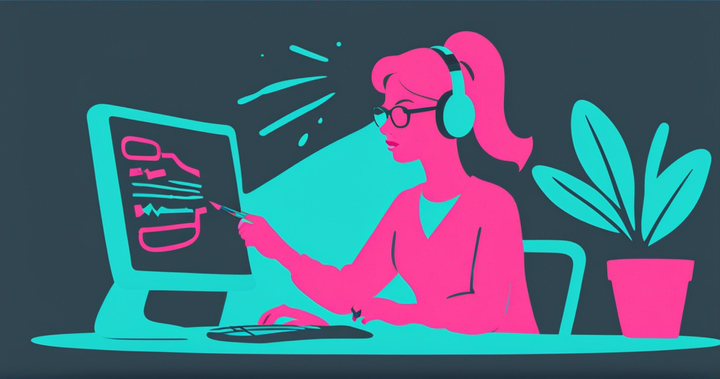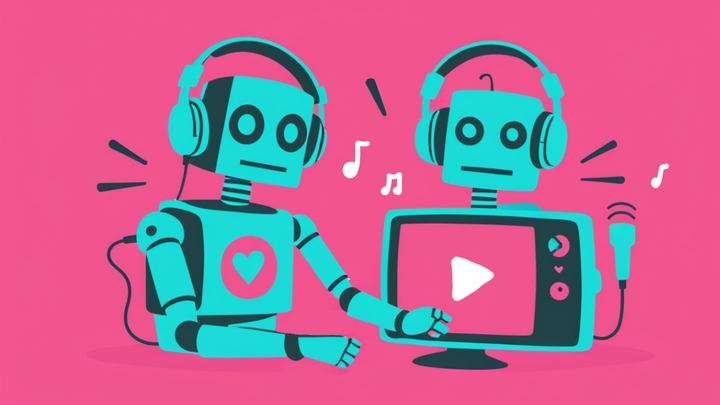Everything You Need to Know About AI for Social Media
AI is everywhere these days, including social media! Here's our total guide for how AI is used by social media platforms as well as how you can use AI in your social media content planning and creation.
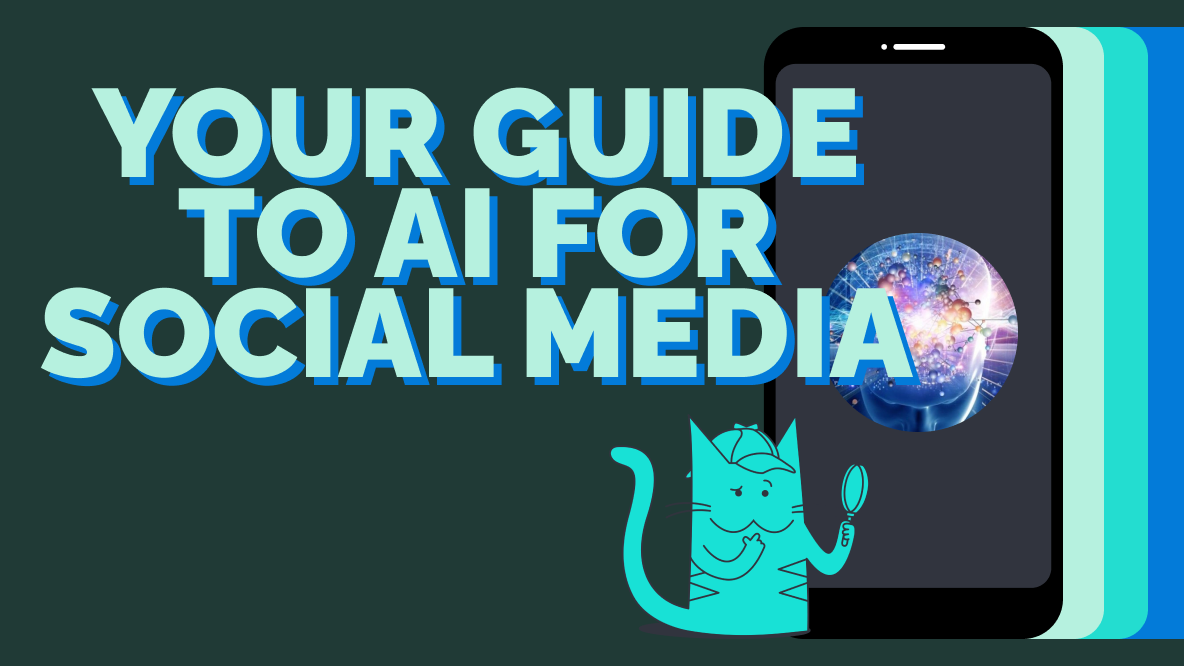
If it seems like everywhere you turn you’re hearing about AI, it’s not just you. Artificial intelligence has grown leaps and bounds recently, with AI applications appearing for everything from writing, to customer service, to image creation, to music. And social media has been no exception.
Social media platforms have been routinely implementing new artificial intelligence features as technology shifts. AI is used in the algorithms that determine what shows up in your Instagram feed or TikTok For You Page. It’s being implemented in chat bots, for generating closed captioning, and for those fun filters that put makeup or sunglasses on your face.
AI, in a nutshell, is when a machine is able to mimic human decisions by analyzing data and patterns. A key part of that is machine learning — when the AI is able to make predictions all on its own.
There are two main ways artificial intelligence plays a role on social media:
- AI used by a social media platform itself to improve user experience
- AI used by users themselves for content creation
In both cases, AI on social media has completely changed how these platforms work, and how they are used by both creators and those engaged in social media marketing. Let’s take a deeper dive into how AI is used on social media platforms and how you can harness the power of AI tools to level up your social media marketing.
How Social Media Platforms Are Using AI
First we’ll take a look at how social media platforms have implemented artificial intelligence, from their algorithms, to chatbots, to automatic translations.
Algorithms
The use of AI in social media that you interact with most is your personalized content feed.
Every user has a unique home feed, whether that is your feed on Instagram, your For You page on TikTok, your Shorts feed on YouTube, or your homepage on Facebook. Sometimes these feeds are tailored to contain posts from accounts you follow or are friends with, but they also have posts or videos inserted from accounts you don’t know.
Platforms use AI to determine what to show in your feed in hopes of getting you to stay on the platform longer. Through machine learning, the algorithm analyzes your past viewing history and interactions to determine what you like to see the most, then delivers it to you. For example, if you often interact with beauty influencers on Instagram, the feed will start showing you more beauty content, even from accounts you don’t follow. Or if you watch a few Reels that people recorded at the Taylor Swift Eras Tour, you’ll start to see more Reels of footage from the Eras Tour (to really stoke that FOMO).
This works for ads, too. In the above examples, the algorithm will know to show you ads from makeup and skincare brands or target you with campaigns from TicketMaster and Seat Geek to buy overpriced tickets to see Taylor Swift.
Filters
Everyone loves playing with filters on social media — whether it’s transforming the gender of your appearance, aging your face, applying virtual makeup, or adding a flawless beauty filter.
The earliest social media filters were on Instagram and were just simple color and lighting effects. That evolved over time to 2015 when Snapchat added lenses that used AI and facial recognition to add dramatic, real-time effects to photos and videos. You may remember some of those early filters, like being able to puke a rainbow.
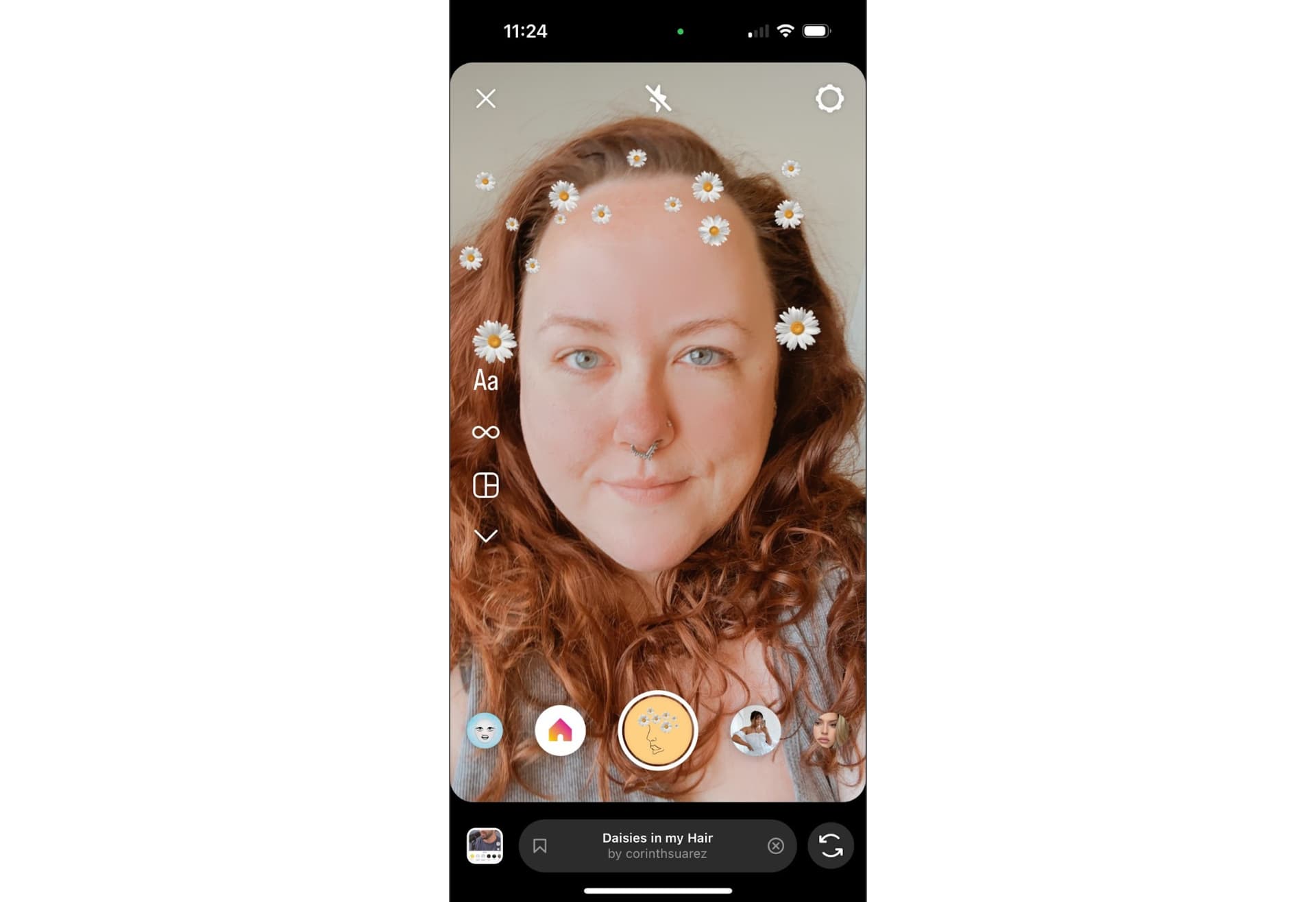
Filters have gotten much more sophisticated since then. Now, they can analyze the contours and features of your face and precisely apply effects like makeup. Then, using object tracking, it can keep that filter on even as you move your head or place an object in front of the camera. And AI means that can all happen in real-time, creating hilarious and engaging user experiences.
Auto-captioning and translation
AI has also made social media more accessible, both for those with disabilities and for those who speak different languages.
AI is able to analyze the language spoken in video content and automatically create subtitles. You can find this feature on YouTube, TikTok, Instagram, and Facebook. On YouTube, for example, you can click the gears icon and turn on auto-generated subtitles.
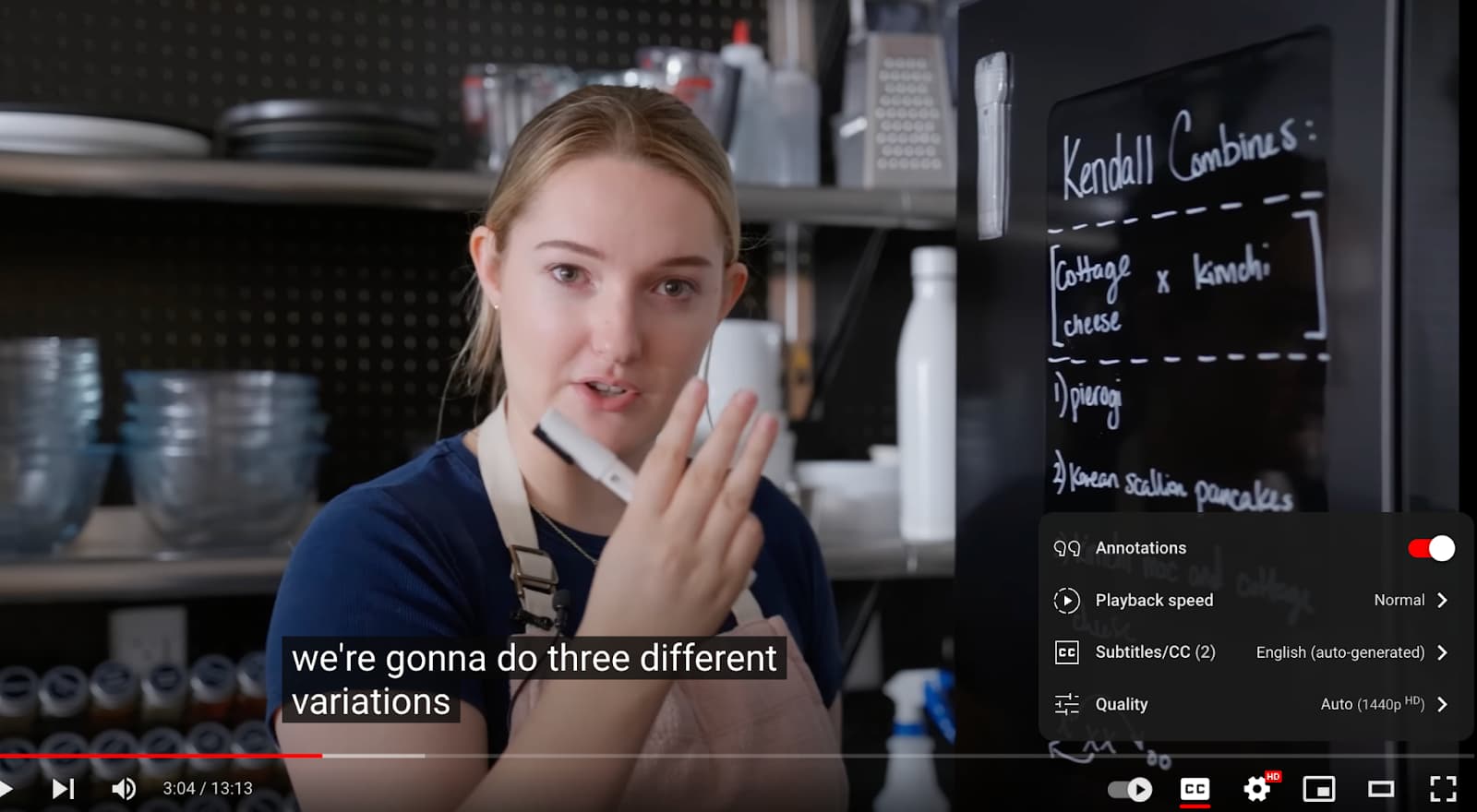
On TikTok, you can tap to turn on captions on any video under the share options.
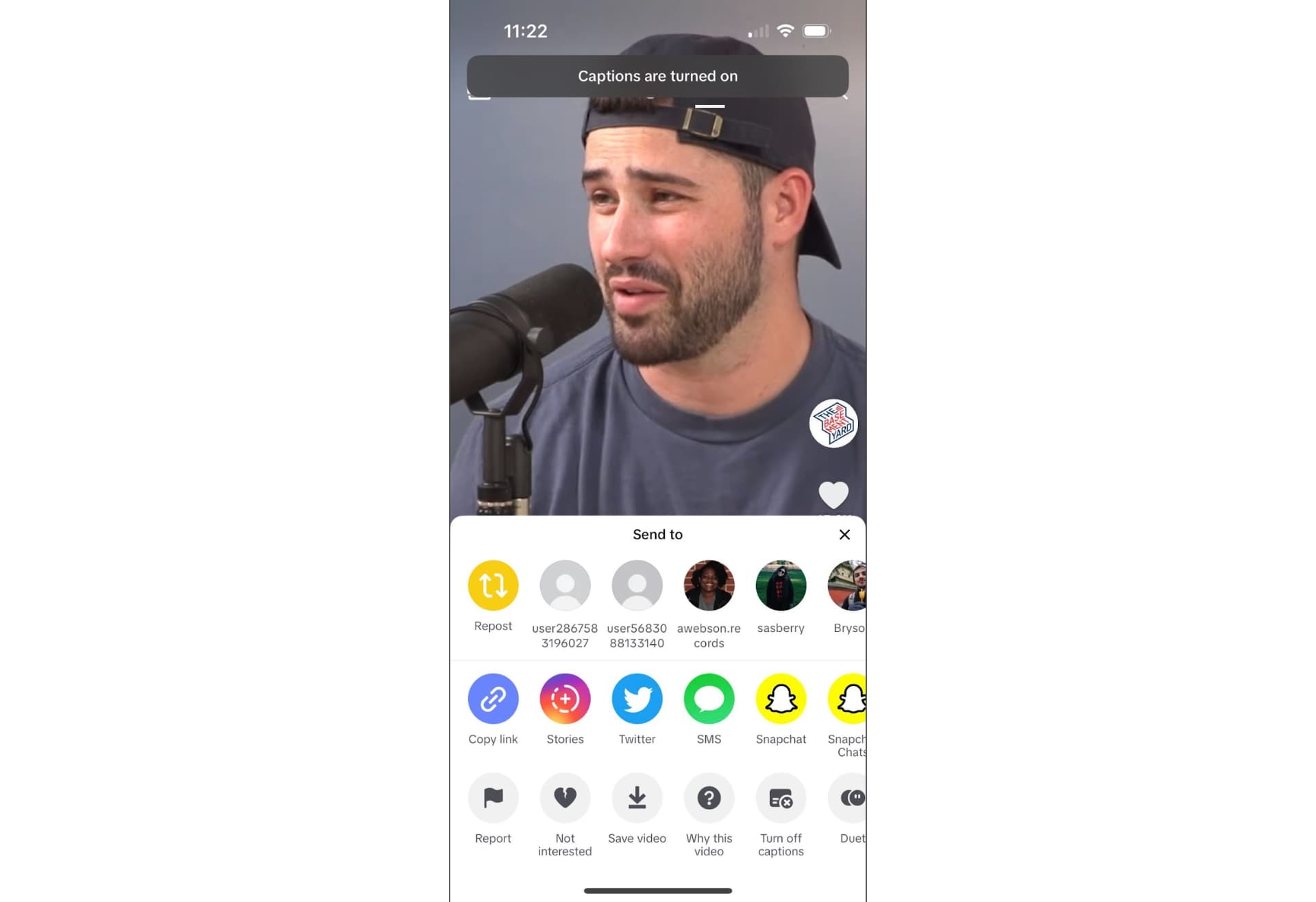
And not only can these apps automatically create captions, they can also translate them in real time. On YouTube, for example, you can set up translated captions in dozens of languages, from Afrikaans to Zulu.
That means no matter what language you use to create social media posts, people from around the world can enjoy them.
Interactive bots
The next wave of AI on social media is coming in the form of intelligent chatbots that have natural language processing capabilities. You’ve probably heard of ChatGPT and its competitors. It’s the same idea, but baked into social media apps.
TikTok for example has been testing a chatbot named Tako. It’s able to interact with users and offer personalized video recommendations based on each user’s interests. You’ll be able to ask it questions as if it’s a person, rather than just typing some keywords into a search bar. It’s currently in the very early stages and being tested only in the Philippines, but if it ever gets a wider release experts say it will radically change how people use the app.
Another example of this kind of AI is Spotify’s AI DJ. It acts like a personal radio, playing songs it knows you’ll love along with commentary and facts in between songs.
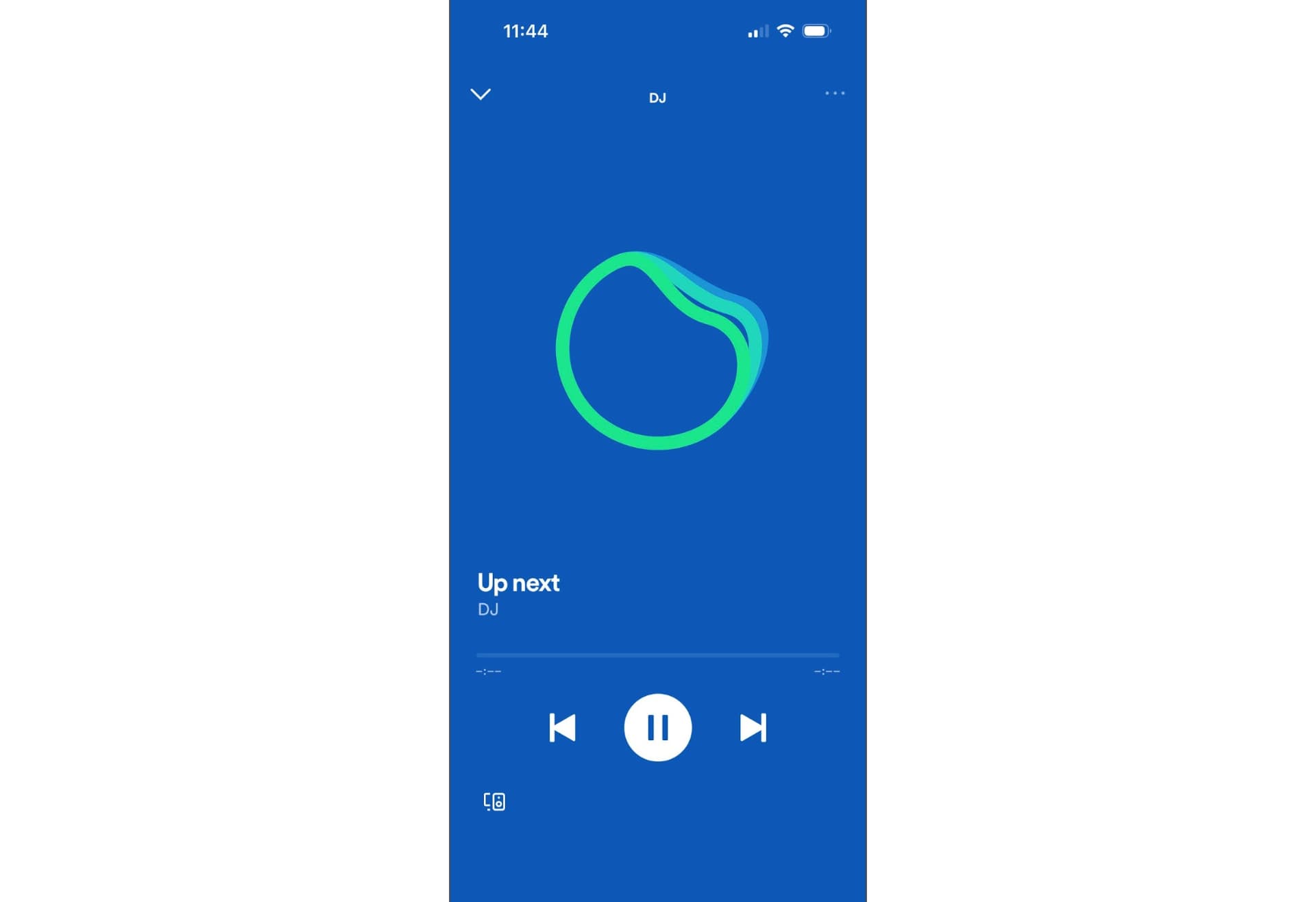
These social media tools are becoming increasingly available and you can expect to see other platforms jumping on the trend.
Moderation
Finally, platforms use AI for content moderation. AI is able to analyze text, images, video, and even livestreams to detect coarse language, graphic images, or sexually explicit content.
Although less precise than human moderators, AI moderation is leagues faster and more efficient than human moderation, and more able to quickly remove offending content. It also means human workers are less exposed to graphic or explicit imagery.
Most apps use a combination of AI and human moderation. AI typically flags offensive content, then a human reviews that content if the AI isn’t 100% certain, or a user claims the removal of their content was in error.
How You Can Use AI on Social Media
We’ve gone over how AI in social media works internally, but let’s talk more about how you as a user can utilize AI for content creation and social media management. Whether you’re an individual creator or a brand with a social media marketing strategy, AI can save time.
Come up with ideas for social media posts
We get it — sometimes it can be hard to come up with ideas for new content on social media. But AI can help!
Try asking an AI tool like ChatGPT for fresh ideas. For example, I asked ChatGPT to give me an idea for an Instagram Reel about my new cat.
It started with a description.
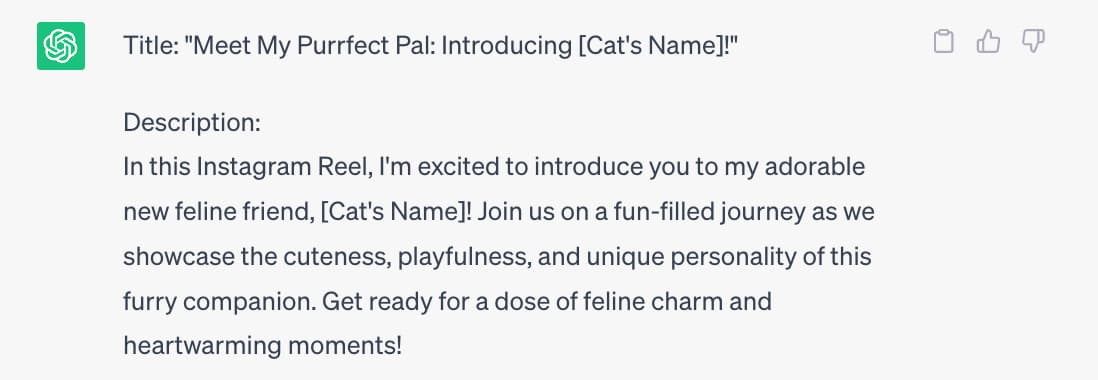
Then it provided shot-by-shot content suggestions.
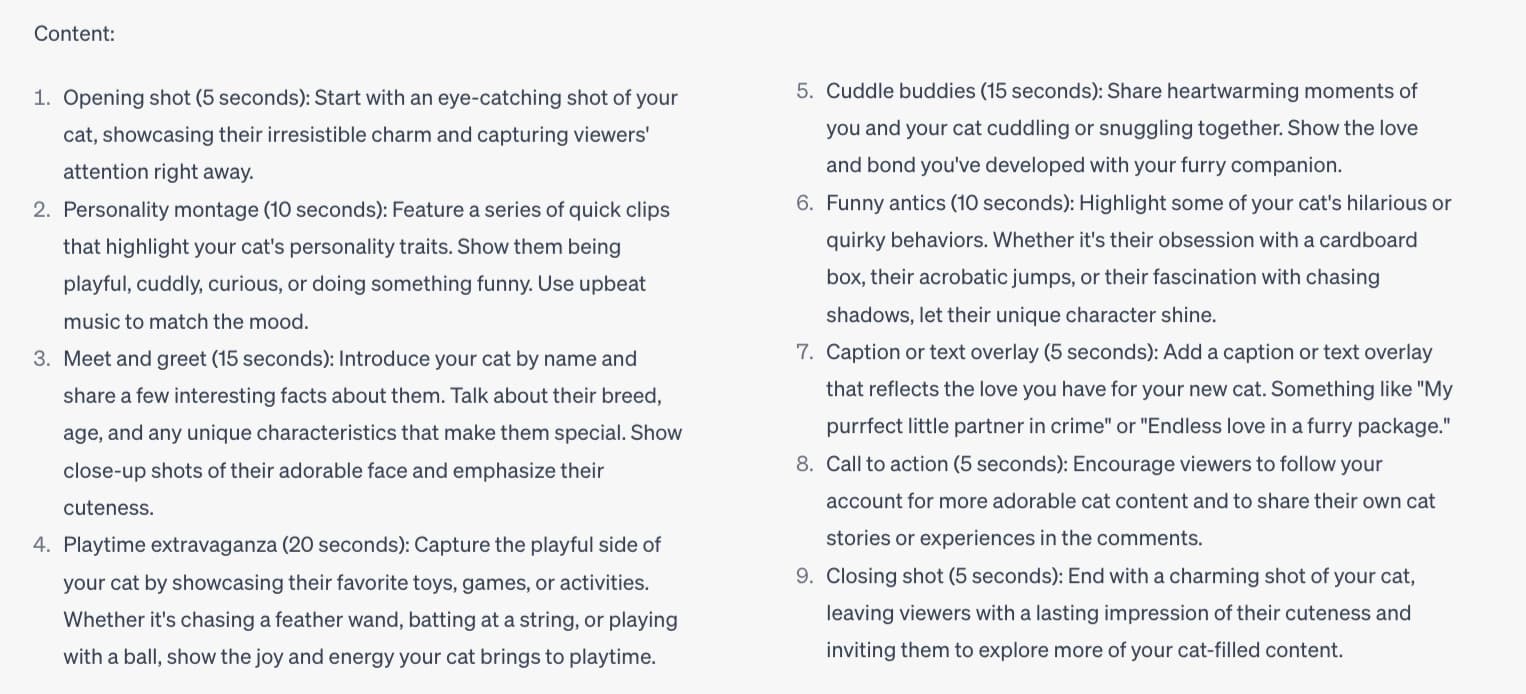
It even gave some tips to end its response.

You don’t have to follow the suggestions that ChatGPT or another AI brainstorming tool gives you verbatim. For one thing, you want your content to have your own unique voice and touch. For another, you don’t want to end up creating the same exact social media post as someone else. Instead, consider AI tools as a great starting-off point — take what it’s suggesting and add your own unique spin.
Give it a try yourself by asking about content for specific social media channels and let artificial intelligence and a bit of your own creativity do the rest.
Generate video scripts
AI can also take on the time-consuming process of writing a script for a video to post on social media.
Kapwing has a built-in AI script generator that can create a complete script with just a few inputs from you.
Simply give it a description of the kind of video you want to make, a duration, and a target platform, such as TikTok or YouTube Shorts.
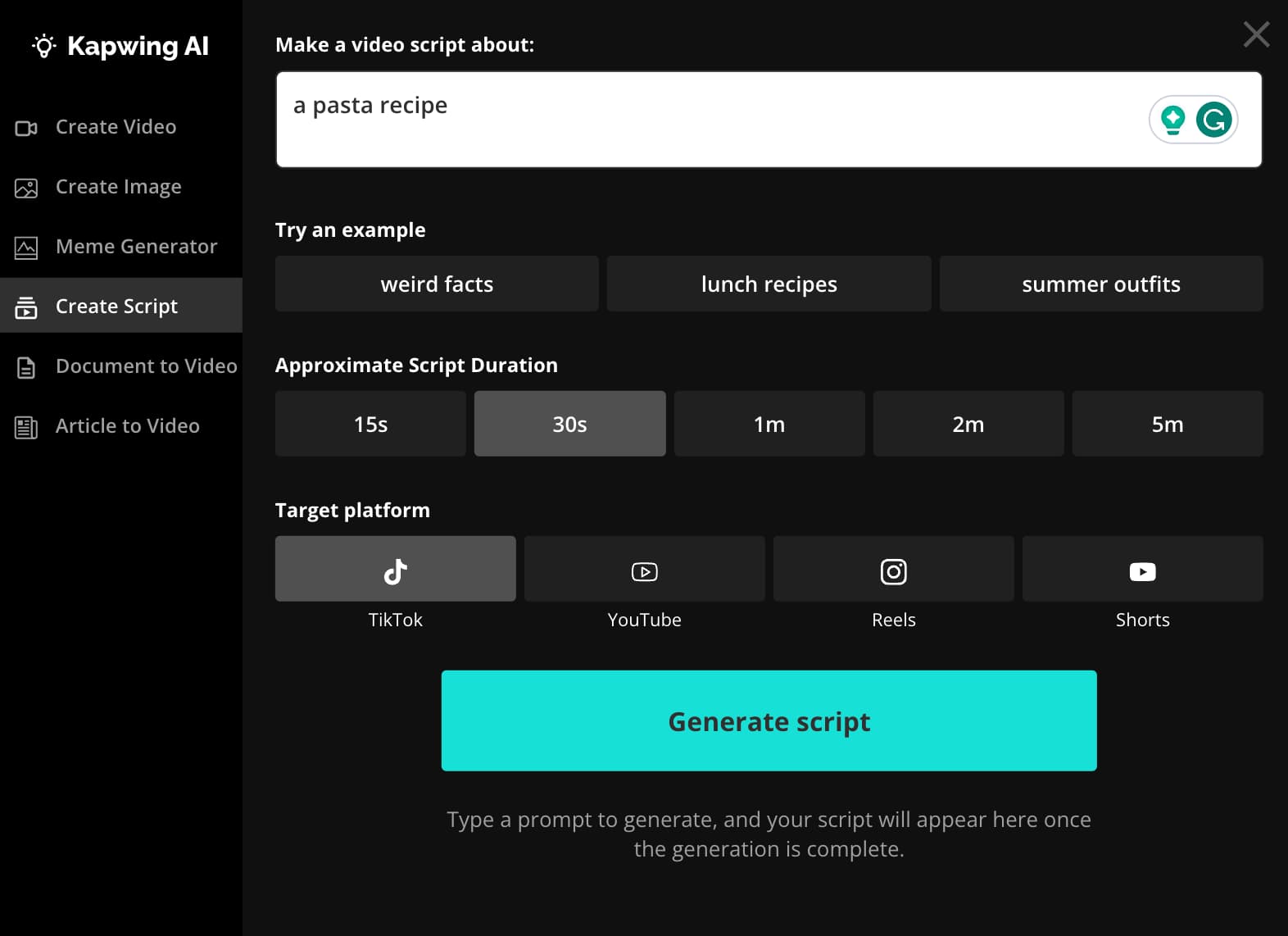
Click the button and Kapwing will do the rest.
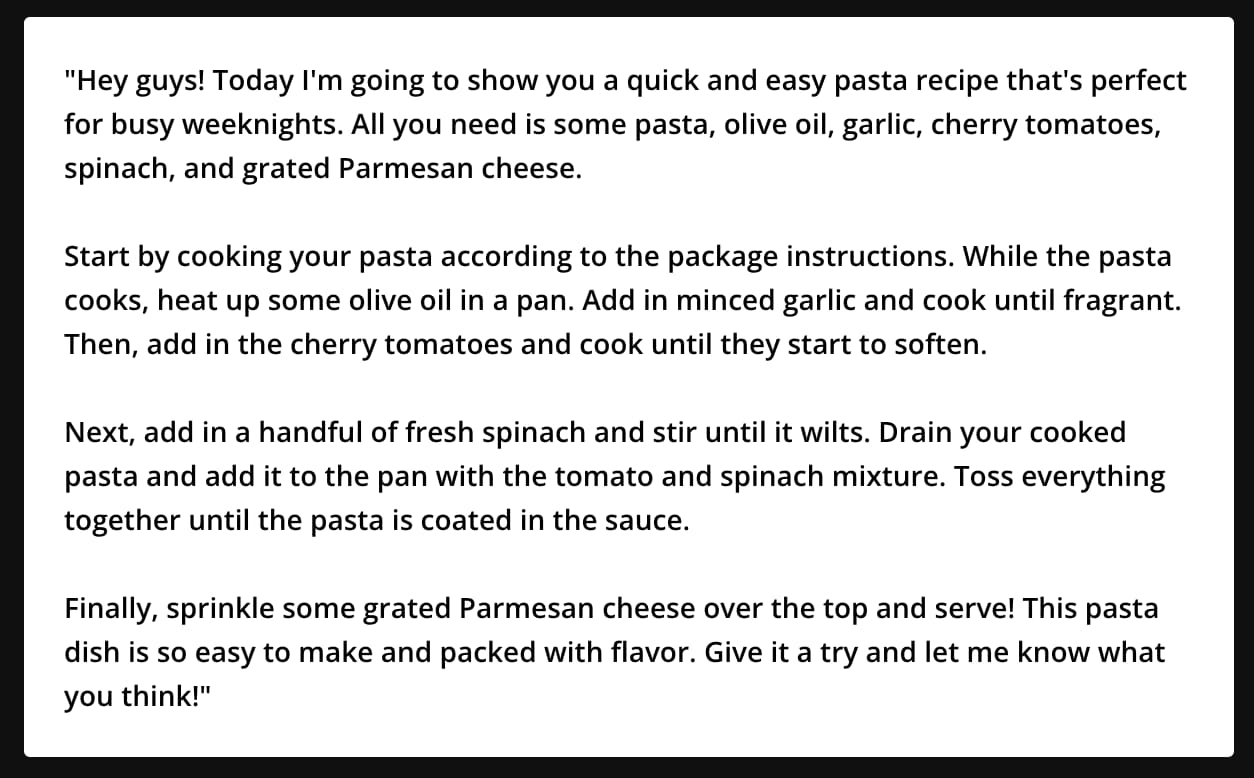
The more detail you can provide, the better Kapwing can create a customized script exactly suited to your video project.
Generate a whole video with AI
If you really want to let AI take the reins, Kapwing’s AI video generator can do all the heavy lifting for you when it comes to creating videos for social media. In seconds, you can transform text into a video with AI.
To start, provide a prompt then select the size for your video (which will depend on which social media app you’re posting to) as well as the style of the captions.
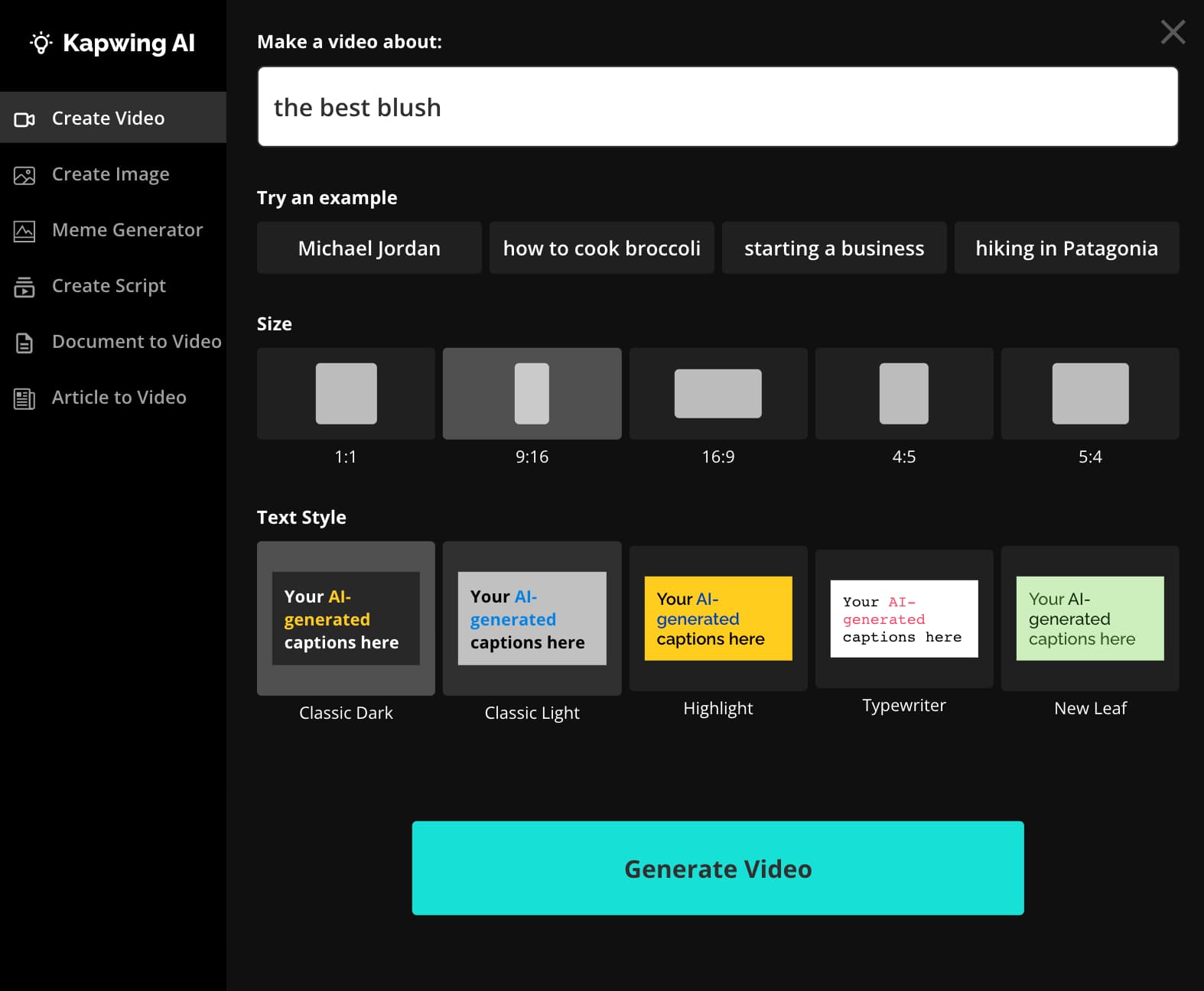
In just a few seconds, Kapwing will create a video complete with clips, text, and music.
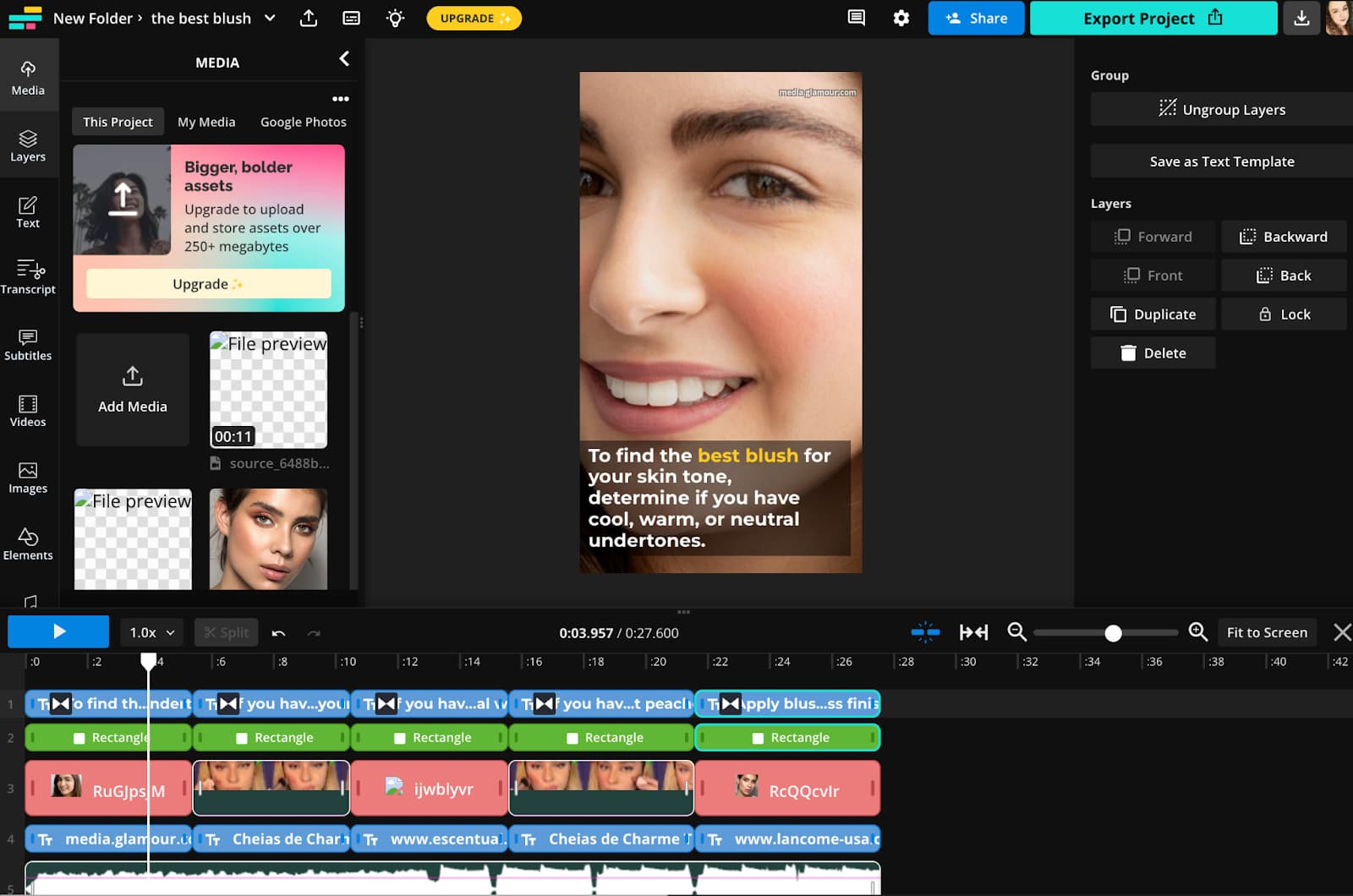
You can then get creative with your own edits, or simply export and post the video to your social media channels.
Generate images
Need an image? AI can do that too! AI-generated images are a great way to create images for videos, including thumbnails, or for static posts on Facebook or Instagram.
To get started, open Kapwing’s AI Image Generator and give it a prompt. In this case, I asked for an image of a golden retriever. I was very specific in my prompt about what I wanted in the image, describing where the dog should be looking and what the background would include. The more detail you can give, the better the results you’ll receive.
The AI tool was able to give me four excellent options that I could then use in a video or other social media post. Generating images can streamline your social media management and make posting just that much easier.
If you're using this resource for your brand, though, be cautious as AI copyright is more complicated than you might think and you may not own the rights to images you've generated.
Related Resources:
- How to Make AI-Generated Images and Art with Midjourney
- The Instagram AI Photo Trend: How to Use Lensa AI
- 5 AI Trends That Are Reshaping Technology
Write social media captions
Even when you have the perfect video, TikTok, or images to post on social media, it can be hard to come up with an engaging caption. Again, AI can help with this..
For example, I asked ChatGPT to write an Instagram caption for a post about a new sticker for my sticker shop.
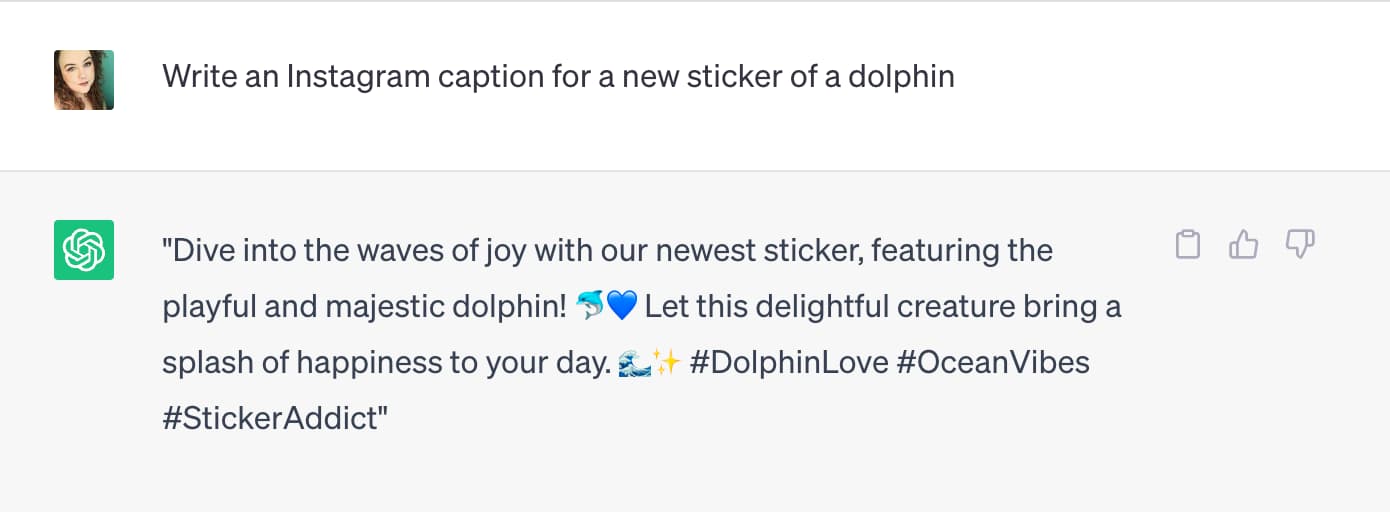
As you can see, ChatGPT wrote a fun caption that even includes emoji and hashtags. Use this as a starting point and reword it to match your brand’s unique voice and add additional hashtags.
This is a great way to boost your social media strategy by quickly filling your calendar with content. This is also useful for marketers who are juggling multiple accounts as part of their social media management.
Many social media management tools, like Hootsuite, are starting to build these features in, so keep an eye out for new AI features in the tools you already use or any new tools you adopt.
Optimize your social media marketing
AI can help with creating ads for social media, too, especially when it comes to generating keywords, writing copy, and defining a target audience. For social media marketers, this can save a lot of time.
For keywords for digital marketing, ChatGPT was able to come up with a list that targets “eyeliner.”
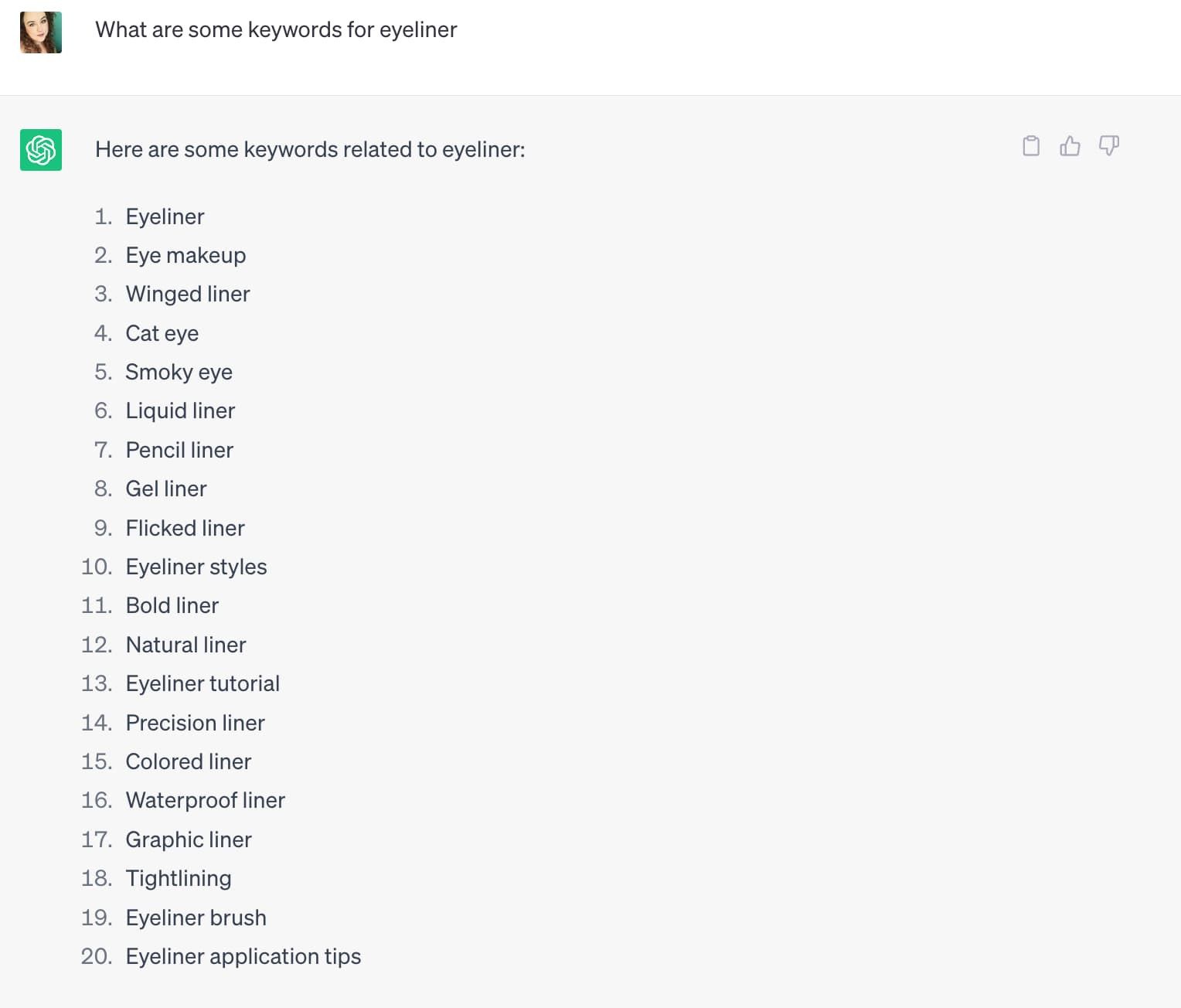
I then asked it to write a social media ad for Facebook for a blue eyeliner, and this is what it gave me:
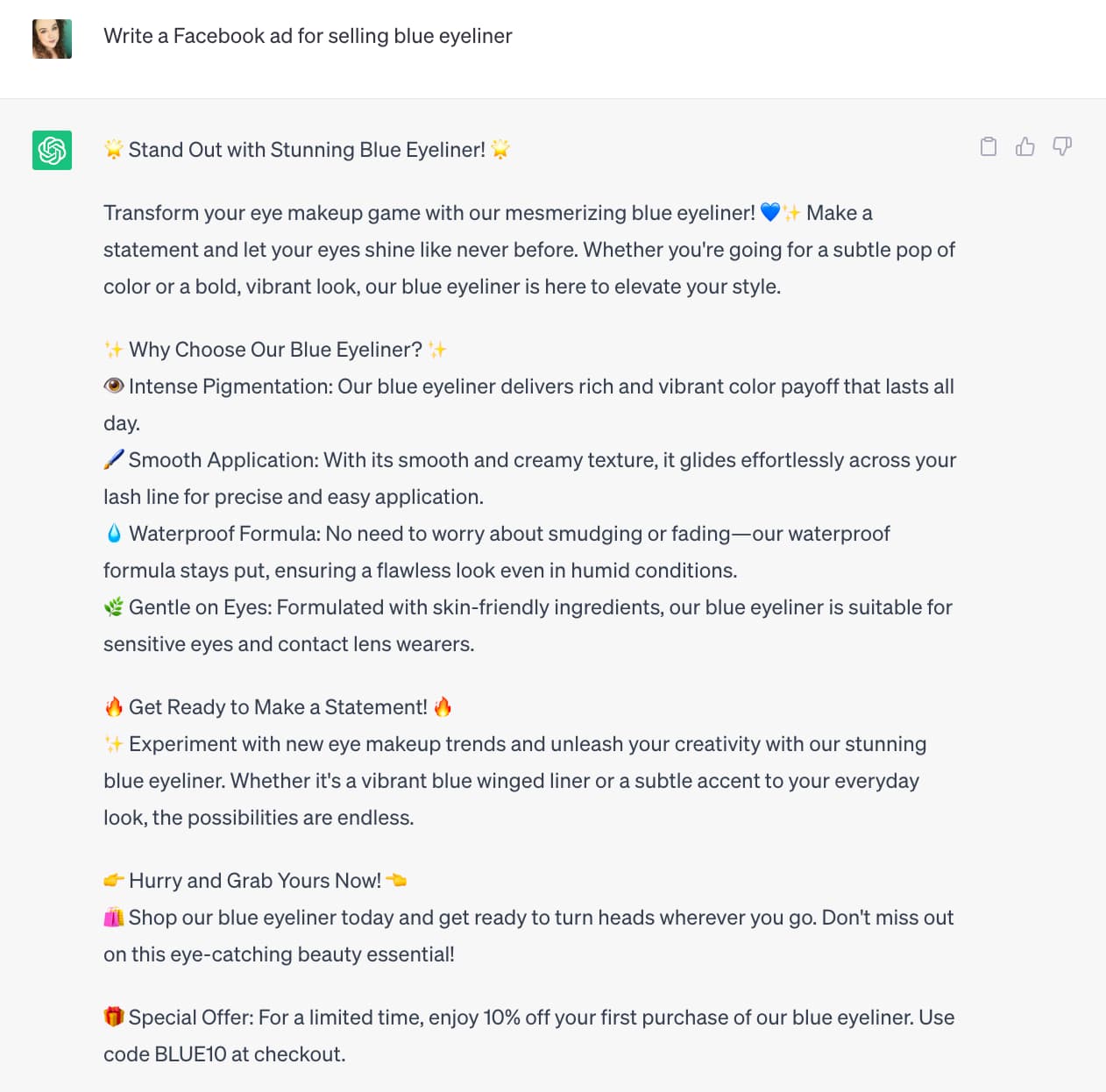
As you can see, it follows the popular format of using emoji lists, and even suggested a discount code to drive conversions with social media ads. Use some or all of the copy in your next ad campaign to speed up the asset creation process.
Is AI the best new thing for social media users?
Artificial intelligence has been fundamental to the development of social media apps, from fine-tuning algorithms to content moderation. It can be found in apps, in social media management tools, and in the content ideation and creation process.
This new generation of AI tools is letting the users themselves use artificial intelligence and machine learning in their social media strategy to optimize, engage, and even create videos from scratch.
Try some of these tools for yourself and streamline your social media management.
AI in Social Media FAQ
What is an example of AI on social media?
AI is all over social media, whether it’s obvious or not. AI and machine learning are used in algorithms to create your unique content feed, to create fun filters, to create subtitles, and even to generate captions. Those are just a few examples — virtually every part of social media has been touched by AI.
How is Instagram using AI?
Instagram uses AI for both the algorithm that determines what’s in your feed, as well as for filters. You can use AI for your own social media management by generating captions to use on Instagram.
How does TikTok use AI?
TikTok uses AI to curate your For You page, to create automatic subtitles, and to create filters that can be used in videos.
Can AI make social media posts?
Yes! You can use AI to generate entire videos and images, as well as captions for social media. Use AI as part of your social media strategy and social media management to save time.
What is the future of AI in social media?
Social media apps are currently experimenting with AI chatbots that can understand and reply in natural language.
Additional Resources:
- Why SAG-AFTRA Members on Strike Are Talking About AI
- What Are AI Hallucinations (and What to Do About Them)
- The 8 Best AI Video Editing Software in 2023

